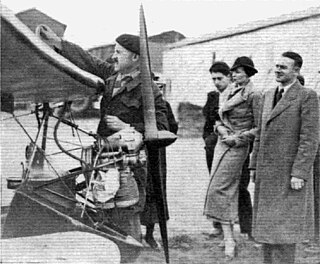External sources
- The SCUD Sailplanes
- Britain's Flea Craze (Archived 2009-10-24)
| Type | Private |
|---|---|
| Industry | Aviation |
| Founded | Wrecclesham, near Farnham, Surrey, 1931 |
| Defunct | ca. 1941 |
| Fate | ceased trading |
| Headquarters | Farnham , |
| Products | Sailplanes, Gliders and light aircraft |
| Owner | L. E. Baynes and E. D. Abbott |
| Parent | E. D. Abbott Ltd |
Abbott-Baynes Sailplanes Ltd. was a 1930s glider manufacturing company based at Wrecclesham, near Farnham, Surrey. It was founded as a subsidiary of E. D. Abbott Ltd in 1931 by L. E. Baynes and E. D. Abbott to build the Scud, a glider designed by Baynes in 1930, the prototype of which was built by Brant Aircraft Limited at Croydon Airport. The Scud was popular, and in 1932 a development of it, the Scud II model was launched. In 1935, a Scud II flown by Mungo Buxton took the British Height Record for a glider to 8,750 ft (2,666 m). [1]
Also in 1935, the Scud 3 was rolled out, though only one was built. Sir John Carden requested a sailplane that could be launched unaided, and suggested a retractable engine. When fitted with such an engine, the glider was called the Auxiliary. Baynes later went into partnership with Carden as Carden-Baynes Aircraft Ltd of Heston Aerodrome, Middlesex to build the Carden-Baynes Auxiliary and the Carden-Baynes Bee. [1]
In 1935, Abbott-Baynes Sailplanes took part in the Flying Flea craze by launching the Baynes Cantilever Pou, which Baynes designed to address some of the aerodynamic problems of the original Mignet HM.14 Pou du Ciel. A series of fatal accidents led to restrictions on aircraft of this tandem wing type, ending the company's interest. [1] [2]
A Scud II built in 1935 (ex-BGA 231/G-ALOT) is still airworthy, and is believed to be the oldest flying glider in the United Kingdom.[ citation needed ] In December 2009, it became part of the Shuttleworth Collection. [3]
Source: Ellison [1]
Carden Aero Engines Limited was a 1930s British fixed-wing aero-engine manufacturer, based at Heston Aerodrome.

Ashingdon is a village and civil parish in Essex, England. It is located about 2.5 miles (4 km) north of Rochford and is 13 miles (21 km) southeast from the county town of Chelmsford. The village lies within Rochford District and the parliamentary constituency of Rayleigh.

The Flying Flea is a large family of light homebuilt aircraft first flown in 1933.

Leslie Everett Baynes, AFRAeS was an English aeronautical engineer.

Sir John Valentine Carden, 6th Baronet MBE was an English tank and vehicle designer. He was the sixth baronet of Templemore, Tipperary, from 1931.
Abbott of Farnham, E D Abbott Limited was a British coachbuilding business based in Farnham, Surrey, trading under that name from 1929. A major part of their output was under sub-contract to motor vehicle manufacturers. The business closed in 1972.

Henri Mignet,, was a French radio engineer who became well known as an aircraft designer and builder. His most famous design is the Flying Flea family of aircraft.

The Slingsby T.12 Gull was a British single-seat glider designed and built by Slingsby Sailplanes and first flown in 1938.

The Carden-Baynes Bee was a 1930s British two-seat aircraft, with twin engines in pusher configuration buried in the wings. The wings rotated for storage. Financial problems limited the Bee to a single flight.

The Carden-Baynes Auxiliary was the first motor glider with a retractable engine and propeller; it is known as the Abbott-Baynes Scud 3 when engineless. Both aircraft, built in the mid-1930s, were still flying in 2010 as pure sailplanes.

The Mignet HM.14Flying Flea is a single-seat light aircraft first flown in 1933, designed for amateur construction. It was the first of a family of aircraft collectively known as Flying Fleas.

Stephen Villiers Appleby was an English pilot and a leading proponent of the Mignet Pou-du-Ciel "Flying Flea" aircraft.
The Abbott Farnham sailplane was a one-off competition sailplane designed and built in the United Kingdom in 1930.

The Abbott-Baynes Scud 1 was a parasol-winged single seat glider intended to introduce pilots to soaring flight. It was built in the United Kingdom and first flew in 1931.

The Abbott-Baynes Scud 2 was a 1930s high-performance sailplane, built in the UK. It was a development of the intermediate-level Scud 1 with a new, high aspect ratio wing.
The Addyman Zephyr was a one-off, single-seat sailplane designed and built by Erik Addyman in the UK for his own use in the 1930s.
The Cloudcraft Dickson Primary was a single-seat primary glider designed in the United Kingdom in 1930 to be constructed from plans. Many glider clubs in the UK and the British Empire flew them in the 1930s.
The Nyborg T.G.N.1 was a single-seat experimental sailplane built in the early 1930s, its unusual wing design a scaled-up version of the wings of large birds.
The Hirth Hi 20 MoSe was a German motor glider designed in the late 1930s. Based on the Göppingen Gö 4 side-by-side seat training glider, it had a foldaway propeller, column-mounted above the fuselage and shaft-driven by a small internal piston engine.
The Bonomi BS.19 Alca was a single seat, tractor configuration motor glider, designed and built in Italy shortly before World War II. It had an unusual retractable undercarriage used only for take-offs. Only one was built.